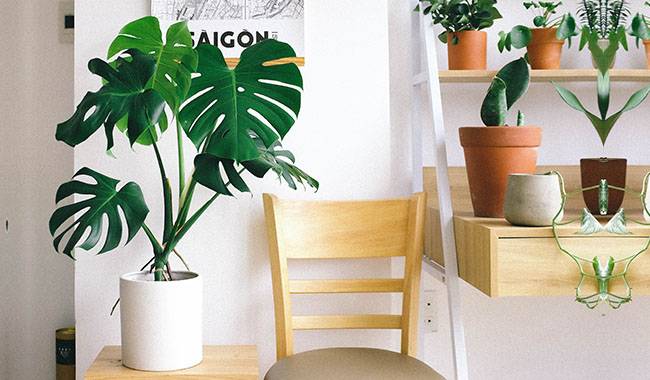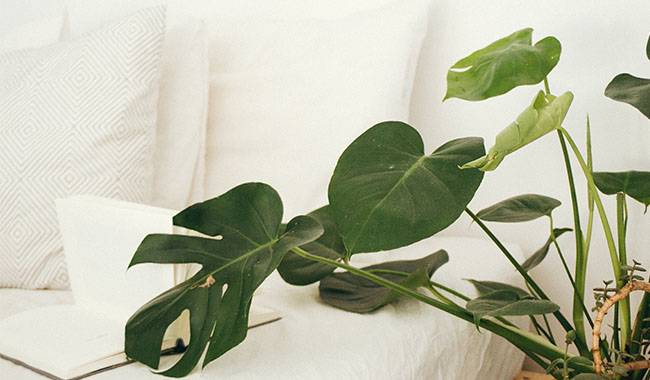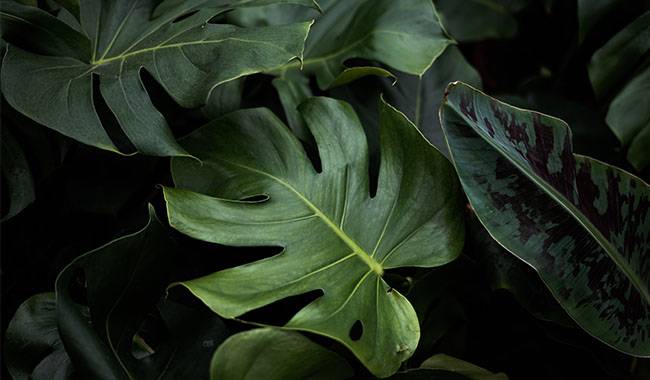
No species has had as bad a reputation among houseplants as Monstera. It was considered a “killer” in different decades and tried to be driven out of the house because of its mythical bad energy and “vampirism.” But these dubious rumors did not in any way affect the gift of improved air or the unique atmosphere that this ancient forest Monstera brings. Special and irreplaceable, Monstera attracts people with its huge narrow leaves, fast growth, and elegance. This undemanding indoor Monstera can be adapted to any place and withstand almost any condition. You will learn how to grow Monstera plants in ThumbGarden’s article.
GIANT MONSTERA WITH VERY SPECIAL FOLIAGE
As the calling card of the whole Tenebrion family, Monstera is a true Monstera. as if it had migrated from the jungle to the interior. Over the years, it can grow from a humble shoot with only a few leaves to a true Monstera, even outshining palm trees that can barely fit through the ceiling. It exudes a primal sense of coolness and tranquility.
Monstera is large-leafed evergreens of the tropics. Even indoors, they can grow unrestricted to about 16 feet (5 meters) (and have plenty of ceiling height). They produce vigorous but slender and unstable shoots and large, long leaves that change shape as they grow. The long, airy, elongated roots only add to their charm: they make Monstera look like ancient, relic interiors.
The leathery, glossy leaves that make this Monstera famous do not appear immediately. The entire “young” flake becomes a pinnately dissected, deeply cut, massive leaf, up to 20 inches (50 cm) in diameter or larger. Cuts and holes appear chaotically and irregularly, and each leaf is unique. Monstera is characterized by the cool, dark green tones that most resemble the forest.
It is one of the poisonous plants: the sap from various parts irritates the skin and mucous membranes. It is best to handle it carefully.
TYPES OF MONSTERA INDOORS
There is mainly one species found indoors – Monstera attractive (Monstera deliciosa). It is the most popular and largest vine, reaching a height of 6.5 feet (2 meters), combining adequate bushes and beautiful aerial roots, the presence of mottled forms, and varieties with white and cream patterns.
Monstera adansonii is an interesting compact species with slender shoots and elongated elliptical lance-shaped leaves up to 20 inches (50 cm) long with almost ovate apertures.
Monstera obliqua is a rare showy species with lanceolate, elliptic asymmetrical leaves up to 8 inches (20 cm) long with beautiful oval perforations.
GROWING CONDITIONS FOR INDOOR MONSTERA

The requirements for Monstera are quite moderate. They need a stable warm, and bright location in a large comfortable room for beautiful and vigorous growth.
Lighting and placement
Monstera is not tolerant of either shade or direct sunlight. They grow well in any diffused light – indoors in semi-shade. Because of their very large size, you cannot place them on a windowsill, but in any bright place, not too far from a window, you can safely place a Monstera as a floor decoration, a camouflage, and a divider. The brighter the light, the larger the leaves and the more prominent the perforations on them.
Monsteras do not like to change position; it is best to move them gradually and carefully, increasing the humidity to compensate for the stress.
Temperature and Ventilation
Monstera does not respond well to temperatures below 59 °F (15°C) and welcomes high temperatures. Their love of coolness allows them to be used to decorate office entrances, hallways, aisles, reception areas, foyers, and lobbies. Summer temperatures of 68-70 °F (20-21 °C) and winter temperatures of 62-64 °F (17-18 °C) are ideal for this large star. Compensate for the high temperatures with more attentive care.
Monstera should not be placed on balconies, much less taken into the garden. They are strictly indoor plants and should be placed in their usual location indoors.
CARING FOR MONSTERA PLANTS AT HOME
All this Monstera needs is regular care without any negligence or extremes. Monstera likes stability.

GROWING CONDITIONS FOR INDOOR MONSTERA
The requirements for Monstera are pretty moderate. They need a stable warm, and sunny location in a large comfortable room for beautiful and vigorous growth.
Lighting and placement
Monstera is not tolerant of either shade or direct sunlight. They grow well in any diffused light – indoors in semi-shade. Because of their huge size, you cannot place them on a windowsill, but in any bright place, not too far from a window, you can safely put a Monstera as a floor decoration, a camouflage, and a divider. The brighter the light, the larger the leaves and the more prominent the perforations on them.
Monsteras do not like to change position; it is best to move them gradually and carefully, increasing the humidity to compensate for the stress.
Temperature and Ventilation
Monstera does not respond well to temperatures below 59 °F (15°C) and welcomes high temperatures. Their love of coolness allows them to be used to decorate office entrances, hallways, aisles, reception areas, foyers, and lobbies. Summer temperatures of 68-70 °F (20-21 °C) and winter temperatures of 62-64 °F (17-18 °C) are ideal for this large star. Compensate for the high temperatures with more attentive care.
Monstera should not be placed on balconies, much less taken into the garden. They are strictly indoor plants and should be placed in their usual location indoors.
CARING FOR MONSTERA PLANTS AT HOME
All this Monstera needs is regular care without any negligence or extremes. Monstera likes stability.
Transplanting, containers, and substrates
Monstera should only be transplanted in March or April when active growth begins. Do not disturb the plant unnecessarily: transplant when the root system has nowhere to develop. Once the maximum container volume has been reached, only the topsoil needs to be replaced annually when no transplanting occurs.
Monstera should be transplanted carefully. When transplanting, it is important to take care of the root ball and the aerial roots, which this process must not damage. The long roots that reach the pot walls are best pushed into the soil with their ends.
Pests and problems in growing Monstera
Monstera rarely attracts pests, and scabies or aphids appear only when neglected.
However, they react vividly to inappropriate care.
- By dropping leaves in high temperatures.
- By lack of gaps, curling, and stretching in the shade.
- By pale and yellowing leaves in too bright a light.
- Shredded and shed leaves in the shade.
Monstera very poorly tolerates nutrient deficiencies. Its leaf tips rarely dry out (only in extremely dry and hot conditions), but they will start to turn black if overwatered.
Propagation of Monstera
In spring and summer, Monstera can be cut off the tips of shoots with a few leaves and aerial roots and rooted in a substrate at a temperature of 68-77 °F (20-25 °C) and watered regularly. There is no need to cover the plants with a hood.
These vines also multiply rapidly by aerial picking. The shoots are cut at the nodes and wrapped in moss or moist soil to secure them to the stems in any convenient way.
This Monstera is rarely grown from seed. It requires shallow seeding, bright light, and constant heat to germinate. Real leaves do not replace the young leaves with the first slits until after a year. You will have to wait longer for the shrub to form: Monstera grows only a few true leaves in the first years.







